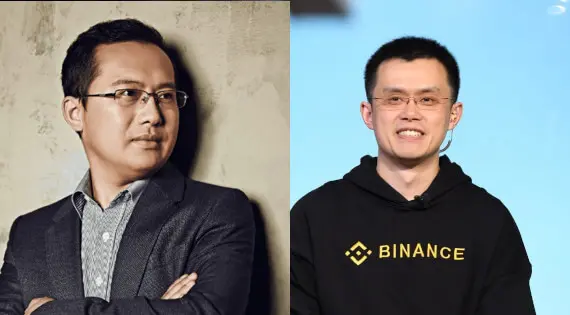The "climate" of Web3 in Asia: a unique technological environment, where the sun of innovation will rise
Original Title: “Celebrating The Web3 Tech 'Terroirs' of Asia”
Author: Allen Ng
Compiled by: Deep Tide TechFlow
Defending the amazing yet underrated local talent, innovative spirit, and resilience in Asia's Web3 space, and the key to navigating the region's unique tech environment.
What do wine and Web3 technology have in common?
“Terroir.” Sounds unfamiliar, doesn’t it?
Not really. For wine experts, the concept of “terroir” may be quite familiar. It refers to a unique set of natural and cultural factors, such as soil, climate, topography, historical context, and regional practices, that make a final product unique, like wine or cheese.

The terroir of wine: from soil to glass. The terroir characteristics of technology: from ecosystems to consumer products.
Most of these characteristics cannot be replicated elsewhere. Therefore, this uniqueness makes these products extremely scarce and sought after, sometimes at astonishing prices.
The same unique factors and combination of excellent products also apply to the tech field. There indeed exists a “unique environment for technology,” with Silicon Valley being the most prominent example. However, over the past two decades, Asia has also developed its own unique “tech environment,” providing an almost unreplicable competitive advantage for world-class Web2 and Web3 social and consumer applications.
The Birthplace of Social Applications
Just as terroir influences the growth of grapevines and the flavor of grapes, the unique environment of technology is also crucial. We in Asia have grown up in an environment filled with unique local social applications, but developing and maintaining this environment in a constantly changing world requires skill and talent.
As a frequent traveler between the East and West, I must say that the stereotype of Asians being only good at mindless reverse engineering and imitation still exists. This notion was present during the Web2 era but is even more pronounced in the borderless and integrated market of Web3. However, the reality is far from that.
The recently popular game “Black Myth: Wukong” is a great example of how Asia can create excellent original products and tell compelling stories at half the cost and manpower of the West.
Do not underestimate Asian developers.
Asia has long been a mobile-first region, with super apps like WeChat, Line, Kakao, or Grab integrating into our lives with unparalleled user stickiness, and the trillions of dollars they have created did not come from nowhere. These achievements stem from the wisdom of developers, the fertile ground of advanced technology, favorable legal and economic conditions, the “dark matter” of social networks, and the vast and growing market driven by hundreds of millions of daily active users eager for new trends.
These tangible and intangible factors constitute Asia's “tech terroir.”

People are often surprised to find that Tencent, the developer of WeChat, is also currently the largest Web2 gaming company. Your favorite IP mobile games, such as “Call of Duty Mobile” or “Harry Potter,” are produced by Chinese game developer NetEase. Products like Xiaohongshu and Bilibili have hundreds of millions of monthly active users across multiple countries. While Robinhood struggles to break even in the U.S., its Asian counterpart Futu continues to earn billions in profits with highly differentiated products.
Their success lies in being social and mobile-centric, allowing users to engage in gaming or e-commerce anytime and anywhere while facilitating social interaction. Tencent helped popularize entertainment in markets often overlooked by non-Asian gaming companies by being the first to adopt a free-to-play model instead of a pay-to-play model, expanding the gaming market and nurturing a vibrant and unique gaming culture in the region and beyond. Xiaohongshu showcases tremendous product-market fit, with its integration of social and e-commerce far surpassing that of Instagram.
The Asia-Pacific region has 1.5 billion active mobile gamers, with a double-digit growth rate. Asian Web3 game developers aim to elevate the accessibility of gaming to new heights through the democratization of game asset ownership and revenue, benefiting those who cannot afford traditional AAA games with new methods and scales.

Trung Nguyen, co-founder of Axie Infinity and SkyMavisHQ, has made waves in the gaming world.
The explosive growth of Web3 games like Axie Infinity developed by the Vietnamese studio SkyMavis and YieldGuild from the Philippines in their respective countries and the broader Asian region is not surprising. There is a wealth of talented developers here, along with a fertile market of mobile gamers and tech-savvy users seeking alternative investments. Hats off to trungfinity (Axie Infinity) and gabusch (YGG) for their bold and innovative attempts to drive the mass adoption of Web3. They essentially pioneered the GameFi market, bringing millions of users into Web3 and inspiring more developers to embark on this journey.

Gabby Dizon is dedicated to building the future of gaming guilds.
In the emerging Web3 innovations, the Stepn phenomenon is also worth noting. Founded by Jerry10240 and yawn_rong, Stepn promotes the concept of “move2earn” fitness applications, integrating Web3 more into our daily lives and attracting a large number of Web2 users as well as top brands like Adidas and ASICS. STEPN has been the top dApp on Solana for nearly half a year. All these novel experiments have largely been overlooked or dismissed by mainstream media.
While the Web3 revolution may not be widely reported on television, innovation and experimentation will continue on-chain and in Asia.
Rugged Terrain, Fertile Terroir

Returning to the metaphor of wine terroir, the “flaws” in vineyards and terrain features such as altitude, slope, and sun exposure can affect the sunlight, moisture, and airflow that grapevines receive. This, in turn, becomes the source of the charm, quality, and uniqueness of the final product. Rugged terrain encourages grapevines to root deeper, yielding more “complex” fruits that can age for a long time.
Similarly, while Asia's economic environment may be challenging in many ways, it is precisely these imperfections that prompt local builders to demonstrate their anti-fragility, resilience, and drive for broader Web3 adoption. As the saying goes, “Tough times create strong men.” However, the challenges are not so great as to hinder the development of Web3 entrepreneurship in certain parts of the world, but just difficult enough to hone imaginative and resourceful builders and shape the future Web3 projects into diamonds. The sweet spot. The perfect terroir.
For instance, six of the top ten countries in global cryptocurrency adoption are located in Asia, surpassing all of North America and Europe, which have not developed in the same economic “difficult environment.” In Southeast Asia, one of the “difficult environments” is the lack of accessible traditional financial infrastructure, creating a vacuum that presents tremendous opportunities for countless small investors, making them a new class of truly Web3 native consumers. For example, only 1% of Vietnam's population owns stocks, but over 10% own digital assets. Just like Axie Infinity, coin98_wallet (founded by serial entrepreneur imlethanh98) has also played a key role in the development of Vietnam's Web3 ecosystem. C98 has over 300 full-time employees, providing diverse products for 9 million users in Southeast Asia and supporting many founders in the ecosystem.

Thanh Le, co-founder of C98
On the other hand, Asian founders benefit from a culture rooted in naturally formed interpersonal guidance, brotherhood, and “relationships.” This cultural atmosphere allows founders to build networks among themselves that can provide invaluable guidance, resources, and “special advantages.” It’s almost like the relationship between Michael Jordan and Kobe Bryant, or the PayPal mafia in Silicon Valley. This may be a challenge for outsiders, but once you work hard to enter this circle and earn trust, it can also become a lasting competitive advantage due to the powerful and unstoppable network effects.

In Asia, business is relationships.
Who Came First? Does It Matter?
Of course, Asia may not be the “first” in the industry, but history sometimes (in fact, often) does not reward the first inventors, but rather shines a spotlight on those who popularize the inventions. The history of wine is no exception. Today, the most prestigious wines come from countries like France or the United States, but in reality, grape cultivation originated in Persian civilization and was spread to the Mediterranean by Phoenician traders thousands of years ago. Who remembers them today? Almost no one.
In the crypto space, Coinbase and Kraken are among the earliest established crypto exchanges, but Asia, especially the Mandarin-speaking world, is the birthplace of the largest and most user-friendly exchanges, such as Binance (czbinance) and OKX (starokx), which now dominate the industry, demonstrating that innovation can still be achieved by building on existing foundations.

Star Xu and Chanpeng “CZ” Zhao, co-founders of OKX and Binance respectively
Whether it’s wine or Web3 projects, they reflect their origins, becoming expressions of their unique terroir. Asian companies benefit from lower development costs and an excellent work ethic, enabling them to iterate faster and provide a better user experience, even if they are not the earliest to appear. I often tell my friends in the West: a million raised in the U.S. is very different from a million raised in Asia. Here, we can do more with less. As Malaysian comedian Ronny Chieng’s stereotype goes, “Things are both cheap and delicious here, and we work while you eat.”

“Need to find someone in charge? Choose an Asian. We work while you eat.”
Overlooked Treasures
When startups receive substantial funding, it usually means they have demonstrated advantages in talent, product, and execution, thus receiving corresponding valuations. However, Asian projects and builders are often underrated, raising less funding than their Silicon Valley counterparts.
We hope to debunk a common misconception that being “cheaper” in Asia means lower quality and can be simplified into a simple, uncreative imitation factory. In fact, many Asian teams are highly efficient under the same fundraising amounts, able to iterate quickly and advance at a faster pace, surprising the world.
Examples abound. The region's nearly inexhaustible pool of quality engineering talent has contributed to the birth of the Solana superteam in India, Vietnam, Malaysia, and the Philippines, driving innovation under the steadfast leadership of calilyliu. For instance, the success of Ethereum's scaling solution 0xPolygon is largely attributed to Indian developers and founders. Malaysia is known for its innovative DeFi projects, such as pendlefi (founded by tnpendle) and JupiterExchange, the largest decentralized exchange on Solana (founded by weremeow), driving the development of DeFi. In fact, even Ethereum itself has deep Asian roots, as Vitalik Buterin personally built communities locally and garnered initial support among Mandarin-speaking supporters.

Sandeep Nailwal, COO of Polygon
The value of Asian Web3 tech companies is like a high-quality wine highly rated by connoisseurs, yet still sold at reasonable prices. Their lower valuations do not imply a lack of appreciation potential or poor quality, nor do they indicate weak fundamentals. On the contrary, these valuations highlight different ways of achieving entrepreneurial success and demonstrate the resilience and adaptability of Asian builders.
Ultimately, a good wine is a good wine, regardless of its origin. This is not a zero-sum game between regions. At EVGHQ, we build businesses and support founders across four continents. But the key is to recognize and celebrate our differences. Asia has nurtured some top-tier tech “Grand Crus.” If you are willing to explore, there are more such companies waiting to be discovered.

Token2049 in Singapore has proven to be a defining event in the industry.
Finally, the grape cultivation practices, winemaking techniques, and historical context passed down through generations in a region also influence the terroir of wine. Asian builders stand on the shoulders of giants, benefiting from this proven business knowledge.
Historically, the development of “business groups” in Asia, which operate different business lines under a holding group (such as Alibaba, Tencent, and Baidu in China, chaebols like Samsung and LG in Korea, corporate groups like Mitsui, Sumitomo, and Mitsubishi in Japan, and family businesses like Charoen Pokphand Group and Kerry Group in Southeast Asia), has formed a unique way of innovation characterized by deep social collaboration, even personal collaboration, and strategic investments with key partners.
We see similar early developments in our Web3 operations group in Asia. For example, Animoca Brands, led by visionary founder and seasoned entrepreneur ysiu, has expanded from a focus on NFTs, IP, and gaming to include digital asset consulting services, Web3 application and platform operations, investment management, and developing institutional blockchain applications. Similarly, Hashed, based in Korea, has expanded its business to Singapore, Silicon Valley, and the Middle East, involving venture capital, incubation, and research.

Yat Siu, co-founder of Animoca Brands
As we mentioned earlier, the social networks in business are the secret weapon of Asia's tech environment, and their importance cannot be overstated. Unlike the West, which values academic credentials and alumni status, in Asia, who you associate with can significantly impact your entrepreneurial development.
Do Not Overlook Asia, “Because When She Awakens, She Will Shock the World.”
As Web3 venture creators at EVGHQ, we recognize and take pride in our Asian roots. Without the large pool of mature, affordable, and hardworking engineers in Asia, we would not be able to develop our products. Our products, such as OpenSocialLabs, a Web3 social infrastructure that enables anyone to build their own community dApps, would not have achieved early network effects without the open-mindedness of Asian users. We at EVG know we stand on the shoulders of giants and remain humble about it. This again proves that Asia is a place where things are happening rapidly.
Whether you are a founder, general partner, or blockchain project, having a solid strategy targeting Asia is crucial to elevate your Web3 project to new heights and breakthroughs. Instead of going it alone, collaborate with local partners or “insiders” who understand the local environment. Spend some time locally to get to know us: a series of top-tier conferences are about to take place, such as kbwofficial in Seoul, token2049 in Singapore, FinTech Week and Chainlink SmartCon in Hong Kong, and efdevcon in Bangkok.
Many Asian founders have created amazing products, paving the way for emerging builders like us. Megaethlabs’ hotpotdao, altlayer’s yqacc, Aptos’ AveryChing, trondao’s justinsuntron, MatrixportEN’s jihanwu, coingecko’s bobbyong, Binance’s heyibinance, Azuki’s ZAGABOND, MagicEden’s ZhuoxunYin, BybitOfficial’s benbybit, kucoincom’s gan_chun, bitgetglobal’s GracyBitget, and many more.
Without you, Web3 would not hold the significance it does today.
Thank you all for the inspiration you provide us. Who knows, the halving cycle in 2024 might just become an “AsiaFi” cycle?
What is certain is: the sun of Web3 will rise in the East. Don’t miss it.










